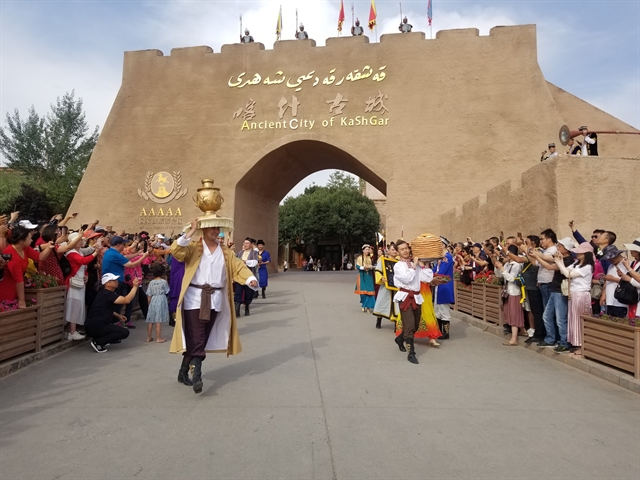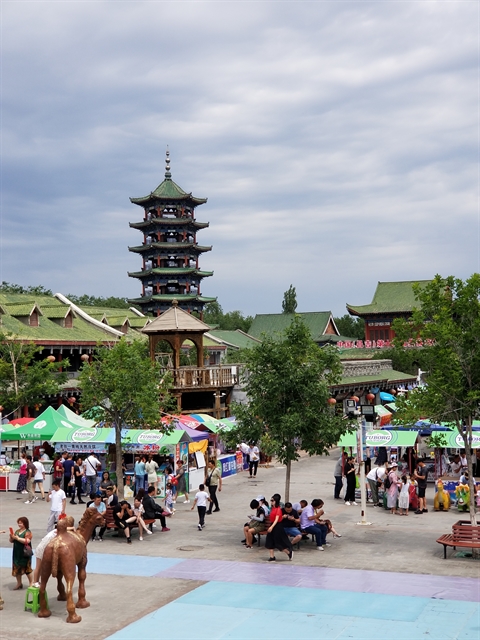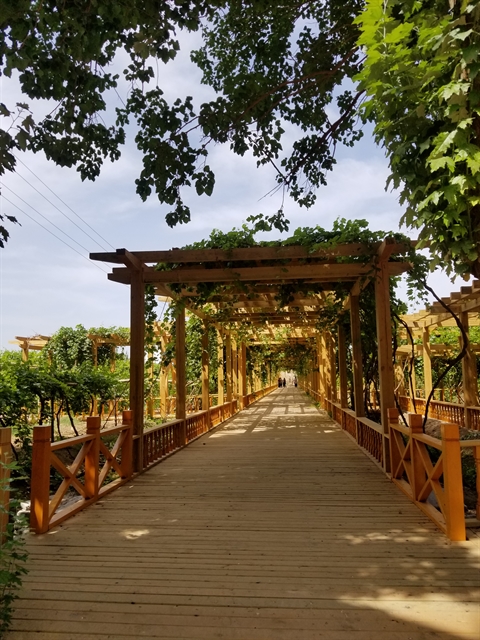 Features
Features

The land, which bridges Asia, Europe and the Middle East, is truly China’s western gateway. Sharing a land border with eight countries: Afghanistan, India, Kazakhstan, Kyrgyzstan, Mongolia, Russia, Pakistan and Tajikistan, Xinjiang has always been an important cultural and trading centre on the ancient Silk Road.
by Hoàng Anh

|
| A ceremony to open the gates to the ancient city of Kashgar is held daily to welcome visitors. VNS Photos Hoàng Anh |
China’s western frontier has always been a bit of a mystery. The vast region, home to large mountains and deserts, is perhaps best known to the world through Chinese classical literature. Journey to the West by Chinese novelist Wu Cheng'en portrays a vibrant place where different cultures and people live together in harmony.
The land, which bridges Asia, Europe and the Middle East, is truly China’s western gateway. Sharing a land border with eight countries – Afghanistan, India, Kazakhstan, Kyrgyzstan, Mongolia, Russia, Pakistan and Tajikistan – Xinjiang has always been an important cultural and trading centre on the ancient Silk Road.
As a passionate reader of Wu’s novel, I have always been fascinated by the land, the people and the colourful costumes. Yet it took a trip to Xinjiang for me to realise that what I’ve read from Wu’s books was but a fraction of how beautiful and magnificent the place is.

|
| People visit a food street in the city of Changji in Xinjiang, China. The city attracts tens of thousands of visitors daily during peak travel seasons. |
Accounting for almost one sixth of China’s landmass, Xinjiang is a big place. That means it has a lot to charm travellers. The landscape keeps changing from the never-ending meadows under the Tian Shan Mountains to vast Gobi Desert, the second largest in the world, to the traditional red brick and green title imperial-era Chinese houses in Changji to the modern metropolitan Kalamayi to the ancient earthen Uyghur town of Kashgar.
Home to some 13 ethnic groups, of which the Uyghur is the largest with 8 million people, Xinjiang offers one of the most diverse and dynamic multi-cultural experience you could hope to find. The land is as rich in history as it is in culture and natural resources.
Here visitors can visit one of the wonders of ancient China: the Turpan water system or known locally as the karez. Comparable to the Great Wall in size, the vast network, which runs a total length of 5,000 kilometres, was painstakingly built by generation after generation of Xinjiang’s inhabitants. Drawing water from some 20,000 glaciers, the karez has been collecting water from the base of the Tian Shan Mountains and channelling it to the lower lands for thousands of years.

|
| Grapevines in the Turpan Depression area. Fed by water from the Tian Shian Moutains, the region produces one of highest quality grapes in all of China. |
The water gives life to Xinjiang’s lust grapevines and lands and helped produce some of the most coveted products in the ancient world. It is said that emperors and kings in ancient times had Xinjiang’s fruits delivered to their palaces thousands of miles away. The secret behind their delicious fruits, the locals believe, is the fresh glacier waters. Pristine and icy cold from the mountains, you can taste the freshness of the purest snow.
Whatever travellers may be doing in Xinjiang, there is one place they simply cannot miss: the ancient city of Kashgar, the crown jewel of the western lands of China. The earthen city is so famous there is a local saying that goes: if you haven’t been to Kashgar you haven’t been to Xinjiang. Originally set up as a stop on the ancient Silk Road, the city’s history goes back some 2,000 years and it is famed, as it has been since antiquity, for its bazaars bursting with spices, furs and pashmina and the Id Kah Mosque, which can accommodate up to 20,000 worshippers.

|
| A local family enjoy afternoon tea in front of their residence in the ancient city of Kashgar. |
Much of the town still remains today. A renovation project undertaken by the local authority has transformed a part of it into the city’s largest tourist attraction with its ancient streets lined up with busy restaurants and shops. That’s not to say you will not be able to find a quiet corner in the Old City of Kashgar, where you may just wonder if you have stepped into the past.
If you are someone who enjoys local culture and authenticity, my advice is to go visit Kashgar sooner than later. There is still much of the local life present in the ancient town and the city’s inhabitants are among some of the friendliest people I’ve met. Walking past an old tea house and feel like some tea and hand-rolled tobacco? You can simply just ask. VNS




